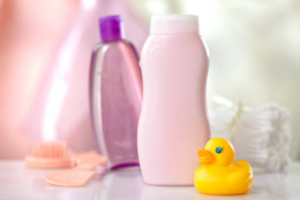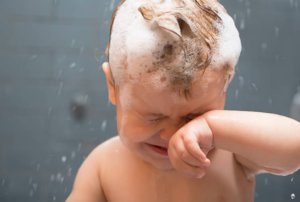Should You Be Concerned About Your Child’s Skincare?

As parents, we are constantly bombarded with choices when it comes to selecting products for our children’s skincare routines. We want nothing but the best for our little ones, ensuring their health and well-being are safeguarded at every step. In recent years, there has been growing concern about the use of sulfates in baby and children’s products. These concerns have sparked questions about the safety and impact of sulfates on young, delicate skin. In this comprehensive guide, we will explore sulfates in children’s skincare, decipher the science behind them, and help you make informed decisions about the products you use on your child.
Sulfates, specifically sodium lauryl sulfate (SLS) and sodium laureth sulfate (SLES), are surfactants commonly found in personal care and cleaning products. These compounds are used for their excellent cleansing properties and their ability to create a foaming or lathering effect in various products. This lathering action makes them popular in shampoos, body washes, soaps, and even toothpaste.
Here’s a closer look at these two common sulfates:
- Sodium Lauryl Sulfate (SLS): This sulfate is known for its powerful cleansing ability. It works by breaking down the surface tension of water, allowing it to spread easily and interact with oils and dirt on your skin or hair. As a result, SLS is highly effective at removing oil, grime, and impurities. This attribute is why it’s often used in products where thorough cleaning is a priority.
- Sodium Laureth Sulfate (SLES): SLES is a close relative of SLS but is considered milder. It is often used in formulations where a gentler approach to cleansing is desired. SLES still provides effective cleaning but with a reduced potential for skin and eye irritation compared to SLS.
How Do Sulfates Work?
Surfactants like SLS and SLES have a unique molecular structure. One end of the molecule is attracted to water (hydrophilic), while the other end is attracted to oils and grease (hydrophobic). This dual nature allows sulfates to surround and lift away oils, dirt, and impurities from the skin and hair, creating a rich lather in the process.
The Lathering Effect:
The lathering effect produced by sulfates has been ingrained in our perception of cleanliness. Many of us associate copious lather with effective cleansing. This is why products that foam generously are often perceived as being more efficient at removing impurities. However, this perception can lead to an overuse of sulfates in personal care products.
The Role of Sulfates in Cleaning:
Sulfates are excellent at what they do—cleansing. They effectively remove dirt, excess oils, and product buildup, leaving the skin and hair feeling refreshed. In the context of household cleaning products, their powerful cleaning action is highly valued.
Should You Be Concerned About Sulfates?
As parents, it’s natural to be cautious about the ingredients in the products you use on your child’s delicate skin. Sulfates, such as sodium lauryl sulfate (SLS) and sodium laureth sulfate (SLES), have raised concerns in recent years. Here, we’ll delve into the factors to consider when evaluating whether you should be concerned about sulfates in your child’s skincare routine:
- Skin Sensitivity: One of the primary reasons for concern is the potential for skin sensitivity. Children, particularly infants and toddlers, often have more sensitive skin than adults. Sulfates, known for their effective cleaning properties, can, in some cases, be harsh on sensitive skin, leading to dryness, redness, itching, or irritation.
- Eye Irritation: Children frequently get soap or shampoo in their eyes during bath time. Sulfates can cause stinging and discomfort when they come into contact with the eyes. This can be a significant concern, as eye irritation can be distressing for a child.
- Scalp and Hair Concerns: Sulfates in shampoos can strip the scalp of its natural oils. While this can be beneficial for those with oily scalps, it may lead to dryness and flakiness in children with sensitive or dry scalps. The potential for scalp irritation is a consideration for parents.
- Allergic Reactions: While rare, some children may be allergic to sulfates. Allergic reactions can manifest as skin rashes, hives, or other adverse skin conditions. If your child has a history of allergies, it’s important to be vigilant about potential irritants like sulfates.
- Toxicity Concerns: Some studies have suggested that when sulfates interact with certain other chemicals, they can produce trace amounts of potentially harmful byproducts. However, it’s crucial to note that these concentrations are typically minimal and considered safe in regulated products. Regulatory bodies such as the FDA and the European Union have evaluated the safety of sulfates in personal care products.
- Personalized Sensitivity: Every child’s skin is unique. What works well for one child may not work for another. It’s essential to pay attention to your child’s individual skin reactions and preferences when using sulfate-containing products.

Choosing Sulfate-Free Products
If you have concerns about sulfates in your child’s skincare products, you’ll be relieved to know that many sulfate-free alternatives are available on the market. These products are formulated to cleanse effectively without the use of sulfates, making them a safer choice for children’s delicate skin. Here are some tips for choosing sulfate-free options:
- Read Labels: Carefully read product labels and ingredient lists. Look for terms like “sulfate-free,” “gentle,” or “safe for sensitive skin.”
- Consider Natural Brands: Natural and organic brands often prioritize sulfate-free formulations. Look for trusted brands that prioritize clean ingredients.
- Consult with a Pediatrician: If you have specific concerns or your child has skin sensitivities, consult with your pediatrician or a dermatologist. They can recommend suitable products based on your child’s unique needs.
- Trial and Error: Every child’s skin is different. What works well for one may not work for another. Be prepared for a bit of trial and error as you find the best products for your child.
Balancing Sulfate-Free and Effective Cleansing
Finding the right balance between sulfate-free products and effective cleansing is essential to ensure your child’s skin remains clean, healthy, and comfortable. Here’s a closer look at how to strike that balance:
- Choose Gentle Cleansers: Opt for sulfate-free products formulated with gentle cleansers. Look for natural and plant-based surfactants, such as those derived from coconut or aloe vera. These cleansers effectively remove dirt and impurities without compromising your child’s skin’s natural barrier.
- Occasional Use of Sulfate-Containing Products: In certain situations, using a sulfate-containing product on an occasional basis may be acceptable. For example, if your child has been playing outdoors and has accumulated a lot of dirt, using a sulfate-containing shampoo once a week can help provide a deeper cleanse without overexposing their skin to sulfates.
- Proper Rinsing: Ensure that you thoroughly rinse your child’s skin and hair after using any cleansing product. Residue left on the skin or scalp can potentially lead to irritation. Take the time to rinse until you are confident that all product has been removed.
- Hydration is Key: After cleansing, use a gentle, hydrating lotion or cream to replenish moisture in your child’s skin. Look for products that contain ingredients like shea butter, aloe vera, or ceramides. Proper hydration is crucial for maintaining the skin’s natural barrier and preventing dryness, especially after using cleansing products.
- Personal Observation: Pay close attention to your child’s skin and their reactions to different products. Every child’s skin is unique, and their sensitivities may vary. If you notice any signs of irritation, such as redness, itching, or dryness, consider adjusting your skincare routine or switching to even gentler products.
- Consult with Healthcare Professionals: If you have concerns about your child’s skincare or if they have specific skin conditions or sensitivities, consult with your pediatrician or a dermatologist. These professionals can provide guidance on suitable products and skincare routines tailored to your child’s needs.
- Patch Testing: Before introducing any new skincare product, especially if it contains active ingredients or if your child has sensitive skin, conduct a patch test. Apply a small amount of the product to a small area of your child’s skin and monitor for any adverse reactions for at least 24 hours.
- Consider Individual Needs: Remember that what works for one child may not work for another. Factors such as age, skin type, allergies, and specific skin conditions can influence the choice of products and the skincare routine that’s best for your child.
- Listen to Your Child: As your child grows and becomes more aware of their own preferences and sensitivities, listen to their feedback. They may be able to tell you if a product is causing discomfort or if they have specific preferences for how they want to be cared for.

Specific Product Considerations
Let’s break down some common skincare products and discuss sulfate-free alternatives:
- Baby Shampoo: Look for sulfate-free baby shampoos that are gentle on your child’s scalp and eyes. These products can effectively cleanse hair without causing irritation.
- Baby Body Wash: Opt for sulfate-free body washes that are formulated to clean without stripping the skin of its natural moisture. Look for hypoallergenic options.
- Bubble Bath: Sulfate-free bubble baths can provide a fun and gentle bathing experience for children. These products create bubbles without harsh chemicals.
- Diaper Cream: Sulfate-free diaper creams are designed to soothe and protect your baby’s delicate skin without causing irritation. They create a barrier to prevent diaper rash.
- Baby Lotion: Choose sulfate-free baby lotions enriched with natural moisturizers like shea butter, aloe vera, or calendula. These ingredients help keep your child’s skin soft and hydrated.

In the journey of parenthood, the choices we make for our children’s well-being are of utmost importance. When it comes to skincare products, the debate over sulfates adds an extra layer of consideration. While sulfates can effectively cleanse, they may pose risks for some children, especially those with sensitive skin.
Opting for sulfate-free products is a practical and safe approach to skincare. These formulations provide effective cleansing without the potential for irritation or harm. However, it’s crucial to strike a balance between gentle cleansing and maintaining the cleanliness and health of your child’s skin.
Ultimately, the choices you make for your child’s skincare routine should align with their individual needs and sensitivities. Consult with healthcare professionals, read product labels, and be open to a bit of experimentation to find the best products that keep your child’s skin clean, healthy, and happy. Remember, as a parent, your informed choices are the best gift you can give your little one.

